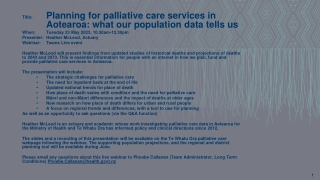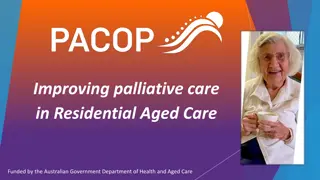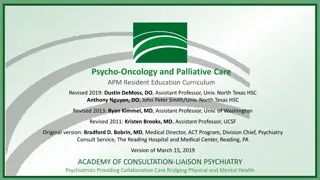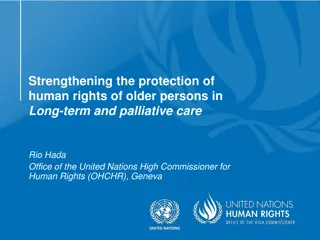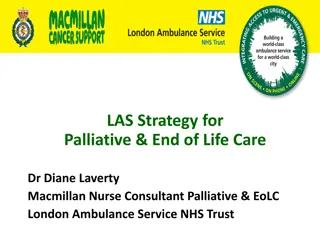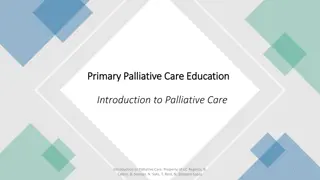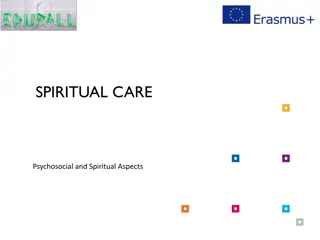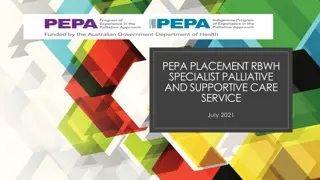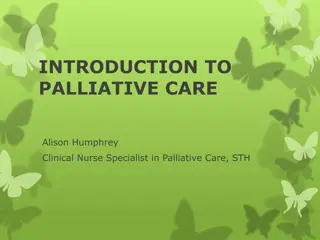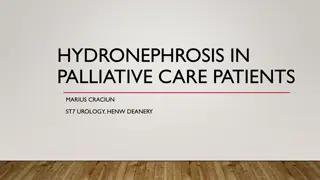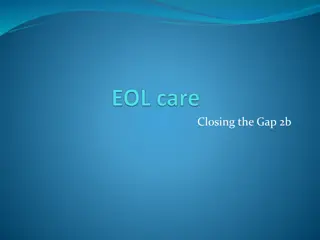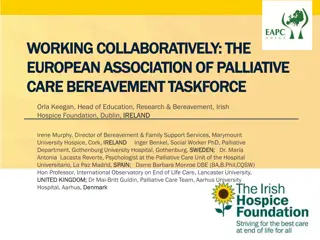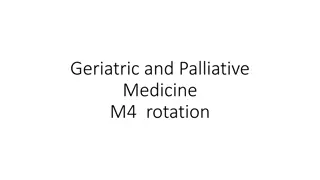Comprehensive Overview of Introduction to Palliative Care
This detailed introduction covers various aspects of palliative care, including virtual meeting etiquette, course disclosures, learning objectives, and participant expectations. It highlights the importance of palliative care in healthcare settings and provides insights into the multidisciplinary care approach and assessment tools utilized in primary care. The course offers CE contact hours for nursing and social work professionals upon successful completion.
Download Presentation

Please find below an Image/Link to download the presentation.
The content on the website is provided AS IS for your information and personal use only. It may not be sold, licensed, or shared on other websites without obtaining consent from the author. Download presentation by click this link. If you encounter any issues during the download, it is possible that the publisher has removed the file from their server.
E N D
Presentation Transcript
Welcome! House Keeping Intro to Palliative Care v5 8.28.2020 2
Virtual Etiquette Meeting participation: If you re connecting on your computer, close-down all other apps and browser windows to eliminate notifications We will be using the raise your hand feature by clicking on the little blue hand We will be using the chat function When we are taking breaks be sure not to leave the meeting but rather mute your audio and video Environment: Be aware of your backgrounds to not be distracting. Position yourself in the light. https://www.gend.co/blog/best-practice-tips-for-using-zoom Intro to Palliative Care v5 8.28.2020 3
MICMT Introduction to Palliative Care-Disclosures Nursing: There is no conflict of interest for anyone with the ability to control content for this activity. Successful completion of the Introduction to Palliative Care course includes: - Attendance at the entire course - must use audio and video to view the live course slides - Completion/submission of evaluation form - Achieving passing score on post-test: 80% or higher Upon successful completion of the Introduction to Palliative Care Course, the participant will earn 2.4 Nursing CE contact hours This nursing continuing professional development activity was approved by the Ohio Nurses Association, an accredited approver by the American Nurses Credentialing Center s Commission on Accreditation (OBN-001-91) ONA Activity# 2020-0000000632 Expiration date: 09/16/2022 Social Work: Upon successful completion of the Introduction to Palliative Care course, the participant will earn 2.4 Social Work CE Contact Hours "Michigan Institute for Care Management and Transformation is an approved provider with the Michigan Social Work Continuing Education Collaborative. Approved provider Number: MICEC 110216. Intro to Palliative Care v5 8.28.2020 4
Expectations What do you want to get out of this training? Intro to Palliative Care v5 8.28.2020 5
Learning Objectives Define palliative care Differentiate palliative care from hospice care Explain whypalliative care is integral to primary care Describe the domains of palliative care Discuss social aspects of care Recognize members of the multidisciplinary care team Identify palliative care assessment tools that may be used in primary care settings 6 Intro to Palliative Care v5 8.28.2020
Palliative Care: YOU Are a Bridge https://www.youtube.com/watch?v=lDHhg76tMHc Intro to Palliative Care v5 8.28.2020 7
Palliative Care and Hospice Care A Population Health Approach 8 Intro to Palliative Care v5 8.28.2020
Definition of Palliative Care Palliative care is an approach that improves the quality of life of patients and their families facing the problems associated with life- threatening illness, through the prevention and relief of suffering by means of early identification and impeccable assessment and treatment of pain and other problems, physical, psychosocial and spiritual. https://www.who.org/ 9 Intro to Palliative Care v5 8.28.2020
Comparing Palliative Care and Hospice Care VS Palliative Care Hospice Care Physical and psychosocial relief Physical and psychosocial relief Focus on quality of life Focus on quality of life Multidisciplinary Team Approach Multidisciplinary Team Approach Any stage of disease Prognosis 6 months or less May be concurrent with curative treatment Excludes curative treatment https://www.nhpco.org/wp- content/uploads/2019/04/PalliativeCare_VS_Hospice.pdf 10 Intro to Palliative Care v5 8.28.2020
Palliative Care is a Primary Care Issue 11 Intro to Palliative Care v5 8.28.2020
Palliative Care Now and the Future Percentage of Hospitals with a Palliative Care Program by Geographic Type 3.0 certified prescribing palliative care providers (MD or APRNs) per 100,000 residents Hospitals with palliative care programs Hospitals that do not currently offer palliative care Urban Suburban Rural 260 208 87 Certified MD Certified NP or CNS Certified RN or Pediatric RN https://reportcard.capc.org Intro to Palliative Care v5 8.28.2020 12
Concentration of spending in high-risk patient populations Top 5% of Health Care Spending Patients who live with serious illness and chronic conditions over years are likely to fall under the category of persistent high- cost patients. 40% 49% The sickest 10% of the U.S. population . When this patient population receives palliative care, quality of life increases, crises are prevented and, as a consequence, medical costs decrease. 11% Last 12 months of life Short term high $ Persistent high $ Accounts for 65% of all health expenditures. Intro to Palliative Care v5 8.28.2020 13
Palliative Care Reduces Avoidable Spending and Utilization in All Settings Source Centers to Advance Palliative Care 48% 50% Admissions 35% ED Visits 43% Hospital/ ED Transfers 36% Total Costs Readmissions 28% Cost/Day INPATIENT OUTPATIENT SKILLED NURSING HOME-BASED Intro to Palliative Care v5 8.28.2020 14
Palliative Care Improves Quality of Life Center to Advance Palliative Care, 2018 Retrieved from https://www.capc.org/tools-for-making-the-case/downloadable-tools/ 15 Intro to Palliative Care v5 8.28.2020
Debbie: Regaining a Quality of Life https://www.youtube.com/watch?v=5M-b1c2spPE Intro to Palliative Care v5 8.28.2020 16
Debbies quality of life changed with the addition of palliative care 17 Intro to Palliative Care v5 8.28.2020
Break https://www.youtube.com/watch?v=5M-b1c2spPE 18 Intro to Palliative Care v5 8.28.2020
Personal Perceptions of Palliative Care Group Activity Intro to Palliative Care v5 8.28.2020 19
We are trained to see disease, we are not trained to see suffering https://www.youtube.com/watch?v=WKSS9E2qy8A 20 Intro to Palliative Care v5 8.28.2020
Domains of Palliative Care 21 Intro to Palliative Care v5 8.28.2020
Domains of Palliative Care Structure and Processes of Care Physical Aspects of Care Psychological Aspects of Care Social Aspects of Care Spiritual Aspects of Care Cultural Aspects of Care Care of Imminently Dying Ethical & Legal Aspects of Care Derived from the Clinical Practice Guidelines for Quality Palliative Care, 4th edition Intro to Palliative Care v5 8.28.2020 22
Structure and Process of Care Begins with a comprehensive assessment and a care plan that is consistent with a patient s values and goals Advance Care Planning: patient and family treatment goals are clearly documented The primary non-medical needs expressed most frequently include: a need to express emotional pain, a need to explore spiritual pain, and a need for practical financial and legal help. Intro to Palliative Care v5 8.28.2020 23
Physical Aspects of Care Assessment should focus on relieving symptoms, improving/maintaining quality of life and functional status - Symptoms may include pain, shortness of breath, fatigue, nausea, constipation, etc. - Lack of assessment is the most common cause of unrelieved pain Care is delivered in a manner that is patient centered as defined by the patient's wishes 24 Intro to Palliative Care v5 8.28.2020
Psychological and Psychiatric Aspects of Care Psychological status needs to be assessed and managed Watch for signs of family members struggling with psychological issues Programs and resources should be available to patients and families based on assessed need for services Process for appropriate referrals: - Directly - Through Consultation - Specialist Referral Intro to Palliative Care v5 8.28.2020 25
Social Aspects of Care Social assessment should address environmental and social factors, including, but not limited to: - Social support network - Financial barriers - Access to care (e.g. transportation, medications) Family Meeting: powerful clinical tool for completing the comprehensive assessment and planning process Warm handoffs and referrals to local/community service providers Intro to Palliative Care v5 8.28.2020 26
Spiritual, Religious, and Existential Aspects of Care Spirituality is a multifaceted, multidimensional human experience that includes religious and nonreligious factors Care Team members must acknowledge their own spirituality Offer support of spiritual counselor: priest, pastor, chaplain, rabbi, imam, or other religious leader Faith, Importance, and Influence, Community and Application (FICA) assessment Cognitive Experiential Behavioral https://clinmedjournals.org/articles/jfmdp/journal-of-family-medicine-and-disease-prevention-jfmdp-3-056.php?jid=jfmdp 27 Intro to Palliative Care v5 8.28.2020
Cultural Aspects of Care Racial and ethnic minorities experience persistent health care disparities Cultural origins influence the way patients and health care providers think about palliative and end of life care Respect values, beliefs, and traditions related to health, illness, family caregiver roles and decision making Incorporate culturally sensitive resources and strategies into the plan of care Remove barriers to communication by ensuring that linguistic needs are met Intro to Palliative Care v5 8.28.2020 28
Care of Imminently Dying Whenever possible, early access to hospice care should be facilitated Place particular emphasis on days leading up to and just after death of the patient - Ensure patient receives adequate management of pain and other symptoms - Avoid inappropriate prolongation of dying - Address spiritual and cultural needs Signs and symptoms of impending death are recognized and communicated to patients and families Provide support and education to the family - Assist in making critical decisions - Relieve possible burdens imposed on loved ones - Develop post-death care and bereavement follow up plan Intro to Palliative Care v5 8.28.2020 29
Ethical and Legal Aspects of Care Address guardianship and goals of care - Identify the health proxy Honor patient preferences or those made by legal proxies or surrogate decision makers Maintain professional boundaries Remain knowledgeable of organizational policies Communicate prognosis essential for informed decision making Intro to Palliative Care v5 8.28.2020 30
Break https://www.youtube.com/watch?v=5M-b1c2spPE 31 Intro to Palliative Care v5 8.28.2020
Identify Members of the Multidisciplinary Care Team Intro to Palliative Care v5 8.28.2020 32
What patients do you think would benefit from palliative care? Intro to Palliative Care v5 8.28.2020 33
Who do you think would benefit? High-risk patients Socially vulnerable Exhausted family caregivers Patients with: - Cognitive impairment - Multiple comorbidities - Frailty - Functional dependency Palliative care can help with illnesses other than cancer: - Advanced lung, heart, kidney and liver disease - AIDS - Alzheimer s disease and dementia - Cystic Fibrosis - Disabling stroke and other neurological diseases - Motor Neuron Disease and multiple sclerosis 34 Intro to Palliative Care v5 8.28.2020
Who provides palliative care? 35 Intro to Palliative Care v5 8.28.2020
Who Provides Palliative Care? Physician Advanced Practice Provider Registered Nurse Social Worker Pharmacist Medical Assistant Dietitian/Nutritionist Patient Family Member or other Loved Ones Spiritual Advisor Community Health Worker Front Office Staff Intro to Palliative Care v5 8.28.2020 36
Aspens Palliative Care Experience https://www.youtube.com/watch?v=OgWdwsNYY3Q 37 Intro to Palliative Care v5 8.28.2020
Patient Focused Approaches Decisions are driven by the patient's goals of care and wishes Provide support to patient to express wishes Provide support to family and caregivers so that patients may realize goals of care Navigate, coordinate a complex/confusing healthcare system, understand the plan of care Intro to Palliative Care v5 8.28.2020 38
Family: Members of the Care Team Central to the delivery of care are family members and/or caregivers: Provide insights into progression, improvement, and quality of life May advocate for patient needs, wishes and desires Source of emotional support and reliability for patients in ever- changing circumstances Provide long-term, 24 hour care with minimal emotional and psychological support Family members benefit from the support of the palliative care team: Experience physical, emotional, and mental stress caring for family member or friend Prone to social isolation and caregiver burden Benefit from support of the overall palliative care team in the form of information, counselling, or practical assistance and training 39 Intro to Palliative Care v5 8.28.2020
Family Related Challenges Family Functioning - May have less than optimal relationships Incongruent patient and family member needs Communication process barriers Impaired concentration Timing and amount of information Family members not wanting to bother the health care team Family members rejection of support Cultural issues and provider comfort level Intro to Palliative Care v5 8.28.2020 40
Family Meeting When possible, the patient should determine who they would like to be present Identify the health proxy Helpful to have members of the care team available to the patient to aid in decision making Ensure an environment where patients and families feel comfortable sharing information Intro to Palliative Care v5 8.28.2020 41
Shared Decision Making Engages patients and families in decisions about their care Increases their involvement and satisfaction Helps patients and families clearly communicate their goals and needs No one right way to intervene https://www.fairhealthconsumer.org/shared-decision-making Intro to Palliative Care v5 8.28.2020 42
Integrating Palliative Care into the Primary Care Setting Intro to Palliative Care v5 8.28.2020 43
Challenges and Opportunities Group Activity 44 Intro to Palliative Care v5 8.28.2020
Challenges and Opportunities Challenges Opportunities Shortage of palliative care specialists Increase access to primary palliative care Develop communication strategies to help patients through the decision making process Lack of knowledge of palliative care still exists with some providers Regional, socioeconomic, racial and ethnic groups influence access to palliative care Leverage EHR and HIE technology to facilitate appropriate referrals Educate all providers and staff about palliative care Care team members may be reluctant to discuss palliative care; fear patients will lose hope Many patients are unaware of palliative care services Increase patient satisfaction, while reducing provider burnout International association for hospice and palliative care Intro to Palliative Care v5 8.28.2020 45
Value of Palliative Care in Primary Care Increased primary care involvement in the care of seriously ill individuals is associated with: - Improved quality of life - Reduced inpatient and ED utilization for seriously ill patients - Improved quality measure outcomes near the end of life Clear guidelines and indications for subspecialty referrals exist for hospitalized patients; these should be adapted for the outpatient setting as well - PCPs responsible for care management - Specialists available for patients with complex needs Intro to Palliative Care v5 8.28.2020 46
How and Where of Palliative Care Gaining Access to Palliative Care Referral from PCP Referral from specialist Referral from care team member Hospitalization Self-referral Hospice Locations for Palliative Care Patient s home Nursing home Assisted living Hospital Ambulatory practice/clinic (Primary Care and Specialty Care) Community-based facility 47 Intro to Palliative Care v5 8.28.2020
Medicare Cost Sharing Eliminate beneficiary cost sharing for patient-centered services - Advance Care Planning - Chronic Care Management Create and expand existing Medicare alternative payment models - Improved quality of care - Quality of life - Health outcomes in patients with serious illness Ensure that all models allow concurrent palliative care and disease treatment Intro to Palliative Care v5 8.28.2020 48
Palliative Care Enhanced Care Model Cure Rehabilitation Survivorship Pain & Symptom Management Hospice End of Life Care Control Bereavement Palliative Care Disease Management Hawley, P,H. (2014). The Bow Tie Model of 21st Century Palliative Care. Journal of Pain and Symptom Management. Retrieved from http://dx.doi.org/10.1016/j.jpainsymman.2013.10.009 49 Intro to Palliative Care v5 8.28.2020
Value of Assessment Tools Patient assessment is a critical step in identifying palliative care needs PCPs need to consider the palliative care needs of all patients with life-limiting illnesses including metastatic cancer, end stage organ failure and advanced degenerative neurological conditions Assessment should address prognosis, current and anticipated symptoms, distress, and the availability and support needs of family and caregivers https://hospicecare.com/home/ 50 Intro to Palliative Care v5 8.28.2020








